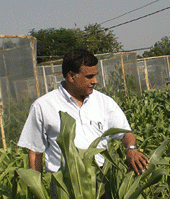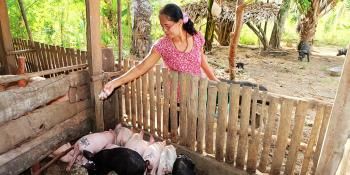"We must support South Asia to deal with unprecedented climatic changes"
This interview with Pramod Aggarwal, Regional Facilitator for the Indo-Gangetic Plains with CCAFS, was originally published in the November CGIAR eNews. Pramod speaks about some of the threats and opportunities that climate change will present in this region and about appropriate responses to them.
 Q: A few years ago, CGIAR scientists published some alarming projections about the probable impacts of climate change on irrigated wheat production in the Indo-Gangetic Plains. What other key crops are likely to be affected negatively?
Q: A few years ago, CGIAR scientists published some alarming projections about the probable impacts of climate change on irrigated wheat production in the Indo-Gangetic Plains. What other key crops are likely to be affected negatively?
PA: It is indeed correct that wheat in the Indo-Gangetic plains is likely to be significantly impacted by climatic change. This crop is very sensitive to any temperature increase, especially during the months of February and March, coinciding with the grain formation and filling stages. Other crops, such as rice, maize, sorghum, cotton, pulses and oilseeds, are also likely to be affected, although it is somewhat difficult to quantify the exact magnitude of the losses due to large uncertainties in future precipitation.
Q: What new opportunities could climate change create in the region’s agriculture?
PA: Since climate change affects all crops as well as livestock and fisheries, with different impacts in different regions, it might give rise to new opportunities. For example, crops such as maize, sorghum and millets could possibly be grown during the winter season in northern India, as temperatures become warmer. Also, crop losses due to frost are likely to decline. In some areas, increased precipitation might encourage farmers to adopt new technologies. In addition, expected changes in the duration of different crops could encourage new land-use patterns. Initial studies indicate that apple cultivation, for example, has started shifting to higher elevations in Himachal Pradesh, as temperatures have become slightly warmer in the lower regions.
Q: In a recent presentation on the capacity of India’s agriculture to adapt to climate change, you gave a brief overview of policy responses to drought since the late 19th century. What new initiatives are policy makers preparing in this and neighboring countries to cope with worsening water scarcity in agriculture, and how will CGIAR research assist them?
PA: South Asia has a very long history of exposure to climatic risks. So, policy makers have been sensitized to the need for action aimed at adapting agriculture to climate change. The prospect of unprecedented changes has prompted most countries in the region to prepare strategic action plans for research and development to increase the resilience of agriculture. These plans put considerable emphasis on increasing water productivity in the region at all scales. The key constraint at this moment is a lack of funds to implement the plans.
The CGIAR can assist national systems by developing closer partnerships with them in developing technologies for climate change adaptation and mitigation. This collaboration should also focus on methodologies and tools that provide policy makers with assistance in their decision making. Decision-support systems should point to integrated solutions encompassing the physical, biological and socio-economic factors that are crucial for addressing the complex challenges of climate change and poverty alleviation. The CGIAR together with national institutions also need to mobilize global opinion behind the creation of funds to support the adaptation of agriculture to climage change.
Q: As a contributor to the work of the United Nations Inter-Governmental Panel on Climate Change, or IPCC, what is your take on the controversy over its prediction about the melting of Himalayan glaciers? How does this affect public confidence in climate science?
This was very unfortunate. What we have to keep in mind is that with such voluminous assessments as those done by the IPCC, involving hundreds of authors and reviewers, it is quite possible for a few errors to creep in. But over the long term, I don't think this will affect public confidence in climate science. IPCC is nevertheless taking several steps to ensure that such errors do not happen in future assessments.


